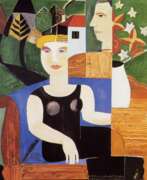Allegory Luminism


Gustave Franciscus De Smet was a Belgian painter. Together with Constant Permeke and Frits Van den Berghe, he was one of the founders of Flemish Expressionism. In 1908, he and his wife followed Léon to the artists' colony in Sint-Martens-Latem. There, they initially came under the influence of Luminism and the painter Emile Claus, who lived in nearby Astene. At the beginning of World War I, he and his family joined his friend, Van den Berghe, and fled to the Netherlands. From 1914 to 1922, they moved about, visiting and staying at the art colonies in Amsterdam, Laren and Blaricum.[2] His meeting with the Expressionist painter Henri Le Fauconnier marked a turning point in his style which, up until then, owed much to Cubism. In 1927, he settled in Deurle. It was there that his mixture of Expressionism and Cubism peaked, with a series of works depicting circus, fairground and village scenes. After his death in Deurle at the age of sixty-six, his house was preserved as a local museum.